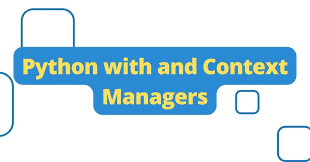Conquering Resource Management: Context Managers and the "with" Statement in Python
 David Oshare
David Oshare
Ensuring proper resource management is a fundamental aspect of writing robust and efficient Python code. Resources can encompass various entities like files, network connections, database handles, and more. Managing their allocation, usage, and proper release (like closing files) is crucial to avoid errors and maintain system stability.
This article introduces context managers and the with statement in Python, powerful tools that simplify resource management and enhance code readability.
Understanding the Struggles of Manual Resource Management
Traditionally, resource management involves explicit code for opening, using, and closing resources. Here's a common example of opening and closing a file:
# Open a file for writing
file = open("data.txt", "w")
# Write data to the file
file.write("This is some data!")
# Close the file (crucial to avoid resource leaks)
file.close()
While functional, this approach can become cumbersome, especially when dealing with multiple resources. It can lead to repetitive code blocks and the potential for forgetting to close a resource properly, resulting in resource leaks or unexpected errors.
Enter Context Managers: Champions of Resource Management
Context managers offer a more elegant and streamlined approach to resource management. They are Python objects that provide a way to automate the allocation and de-allocation of resources.
Here's the key: context managers define two special methods:
__enter__(): This method is called when you enter awithblock, and it's responsible for acquiring the resource and potentially performing any necessary setup.__exit__(): This method is invoked when you exit thewithblock (either normally or due to an exception). It's responsible for releasing the resource and performing any necessary cleanup tasks.
The with Statement: Partnering with Context Managers
The with statement works in conjunction with context managers to simplify resource management. Here's the equivalent code using a context manager:
with open("data.txt", "w") as file:
# Write data to the file
file.write("This is some data!")
# Notice the file is automatically closed after the `with` block exits
The with statement takes a context manager as an argument. Inside the indented block following the with, the resource is guaranteed to be available within the scope. Once the block execution finishes (or if an exception occurs), the __exit__() method of the context manager is called, ensuring proper resource release.
Benefits of Context Managers and the with Statement
Simplified Resource Management: The
withstatement eliminates the need for explicitopenandclosecalls, reducing code clutter and potential errors.Automatic Cleanup: Even if an exception occurs within the
withblock, the context manager's__exit__()method ensures proper resource release, preventing leaks.Improved Readability: Code using context managers becomes more concise and easier to understand, as the resource management logic is encapsulated within the
withblock.
Common Context Managers in the Python Standard Library
Python's standard library provides built-in context managers for various common resources:
open(): This function acts as a context manager for file I/O, ensuring the file is closed after thewithblock exits.threading.Lock(): This creates a lock object for managing thread synchronization. When used in awithstatement, it acquires the lock upon entering and releases it upon exiting.socket.socket(): This creates a network socket object. Using it within awithstatement ensures the socket connection is closed properly.
To add, context managers and the with statement offer a powerful and convenient approach to resource management in Python. By leveraging these tools, you can write cleaner, more concise, and robust code while ensuring proper resource handling and avoiding potential leaks. As you delve deeper into Python development, embrace context managers to streamline your resource management practices and write code that is both efficient and elegant.
Subscribe to my newsletter
Read articles from David Oshare directly inside your inbox. Subscribe to the newsletter, and don't miss out.
Written by

David Oshare
David Oshare
I am a Python developer with 2 years of experience. I love building things with code and sharing that knowledge with others. Looking to collaborate and keep learning!